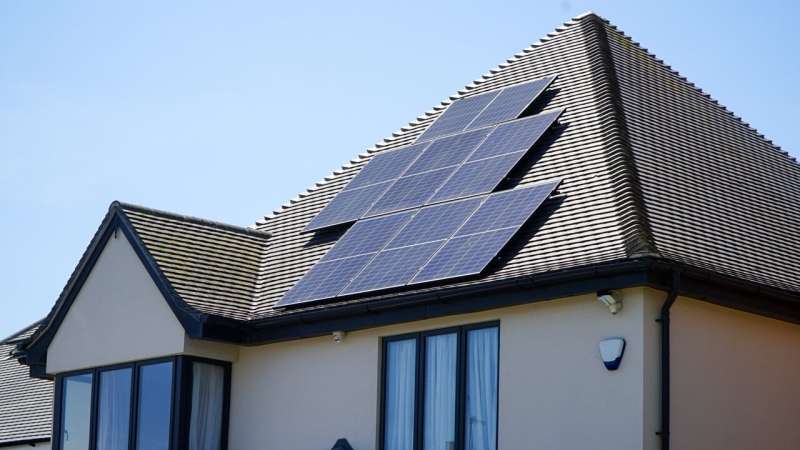This article has been reviewed according to Science X's editorial process and policies. Editors have highlighted the following attributes while ensuring the content's credibility:
fact-checked
reputable news agency
proofread
US reaches a new clean energy milestone, with 5 million solar projects installed

When Peter Gorr got his first solar roof in 2011, he didn't know what to expect.
But installation went smoothly, the smooth black panels lowered his electric bills, and Gorr—who is very concerned about climate change—relished the opportunity to lower his carbon footprint.
He recalled with a chuckle how his wife, Susan, kidded him when he initially hesitated to turn on the air conditioner on a 90-degree day.
"What are you saving—sunbeams?" she asked.
Gorr, who has since moved to a ranch in Deer Park—and installed his second solar roof—is part of a wave of homeowners who have helped the U.S. reach a new clean energy milestone.
The nation now has more than 5 million solar installations, most of them on residential rooftops, the Solar Energy Industries Association announced on Thursday.
The announcement comes just eight years after the nation reached 1 million installations,SEIA said in a news release.
"Solar is scaling by the millions because it consistently delivers on its promise to lower electricity costs, boost community resilience, and create economic opportunities," SEIA President and CEO Abigail Ross Hopper said in the release.
"Today 7% of homes in America have solar, and this number will grow to over 15% of U.S. homes by 2030," she said. "Solar is quickly becoming the dominant source of electricity on the grid, allowing communities to breathe cleaner air and lead healthier lives."
Over 25% of U.S. solar installations have come online since the Inflation Reduction Act became law 20 months ago, according to data released by the Solar Energy Industries Association and Wood Mackenzie, a research and consulting firm.
While 97% of solar installations are at residences, the project count also includes solar systems installed at businesses and solar farms.
Gorr said he's actually surprised that solar hasn't caught on more quickly.
"There should be yearslong waiting lists," he said. "The economics is just so strong—we're talking saving tens of thousands of dollars on electricity."
The warranty period on a solar system is generally 25 years, he said. Over that time period, he expects his current solar roof to save him $30,000 to $40,000 dollars. And that's after subtracting the cost of the system.
Between his electricity savings and his gasoline savings, due to owning an electric vehicle, he saves over $2,000 a year, he said.
Gorr, 71, a retired director of marketing and product management, was always interested in the environment, but when he was younger he was busy with his career and his kids.
After he retired, he looked for an environmental cause to focus on, and zeroed in on climate change.
"This is the worst crisis that humanity has ever faced," he said. "I couldn't sit idly by."
He purchased a solar roof in order to reduce his home's planet-warming greenhouse gas emissions, and was pleasantly surprised to find that, with his electric bill savings and government incentives, he would recoup his costs.
Excited, he gave a presentation at a local library, and went on to become a volunteer solar ambassador at the nonprofit Illinois Solar Education Association, where he is now vice president of the board of directors.
He said he has talked to hundreds of people about the benefits of going solar and some have come back to tell him they heeded his advice.
Among those he has encouraged to consider solar: both of his sons, his brother and his best friend.
All of them now have rooftop solar systems.
Solar installations in the U.S. are expected to double to 10 million by 2030 and triple to 15 million by 2034, according to SEIA.
Illinois, which had only 2,500 solar installations in 2017, now has more than 87,000.
The U.S. has enough solar installations to cover every residential rooftop in Colorado, Utah, Arizona and New Mexico, according to SEIA.
Gorr said he has found that most people who don't have solar don't understand the economic benefits. His most basic message: If you pay an electric bill, you can save money by switching to solar.
People who don't own a home—or don't want to buy rooftop panels—can enroll in community solar programs, which allow you to buy your energy from a solar farm, he said. If you are able to invest in solar panels, you can achieve even greater cost-savings.
And for people with lower incomes, additional financial incentives are available through the state's Solar for All program.
2024 Chicago Tribune. Distributed by Tribune Content Agency, LLC.















